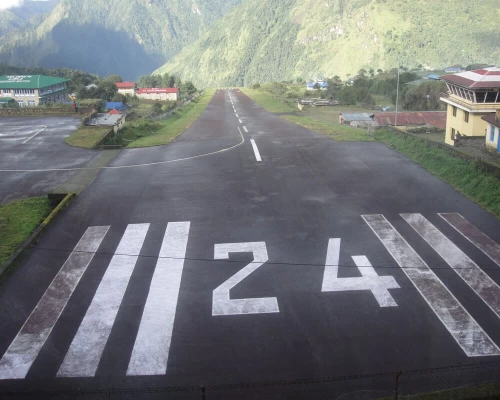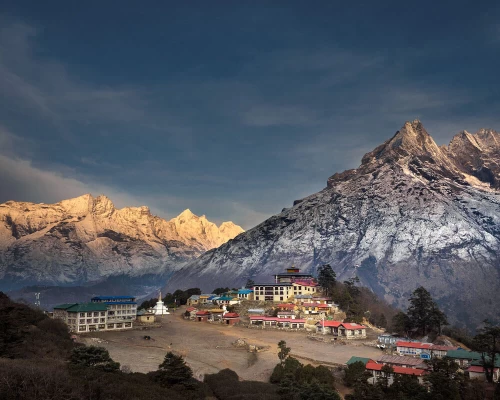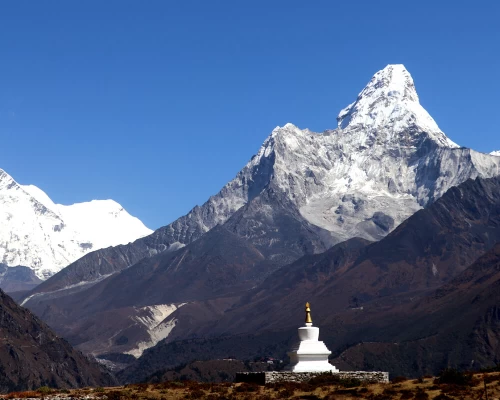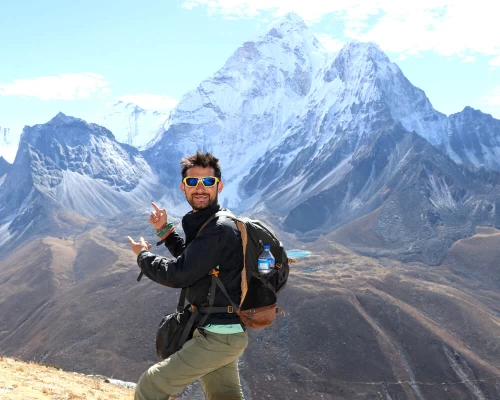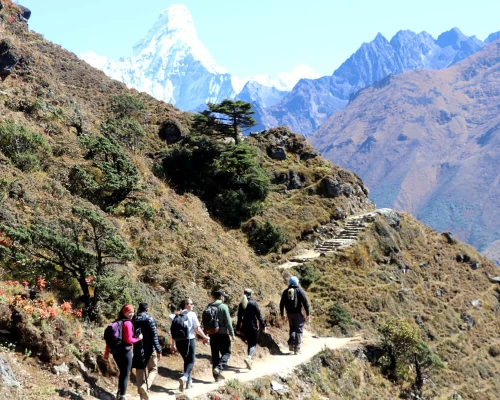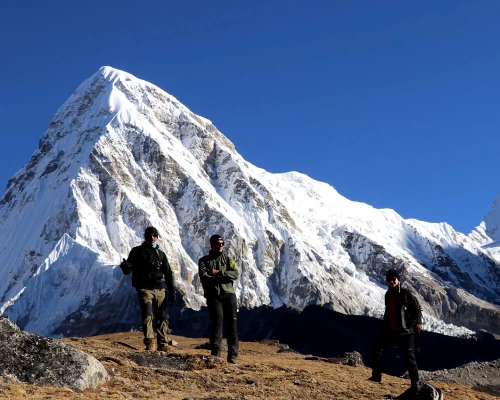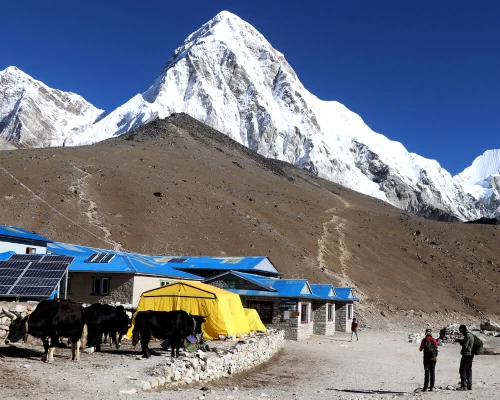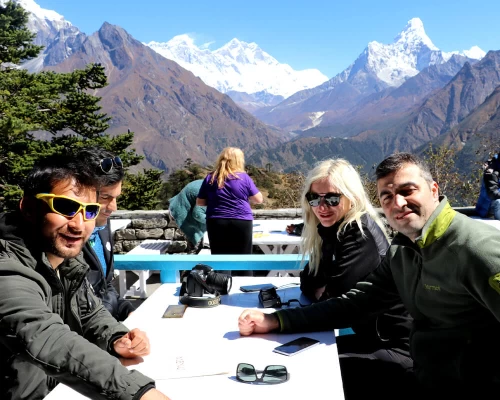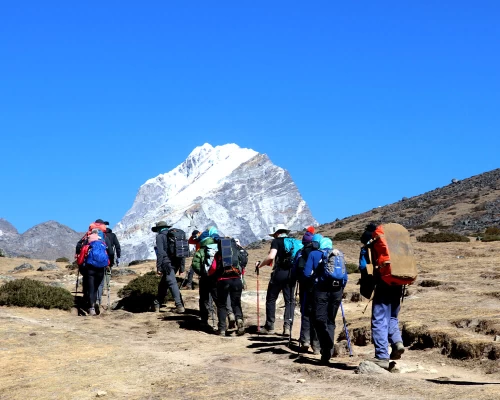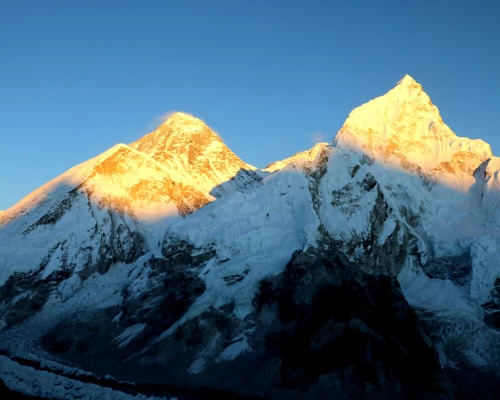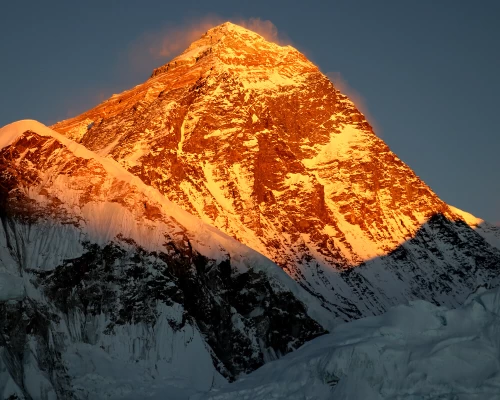Meals On EBC Trek
When it comes to the Everest Base Camp Trek, meals are an important aspect to consider. With Breeze Adventure, you can look forward to a variety of delicious and diverse food options in the Everest region. As a general rule, meals are included in the trip price, giving you the opportunity to try both local and international dishes during your trek. Bon appétit!
Our guides are available to help you choose the right meals and to recommend dishes to try. You can expect to have breakfast in the morning, lunch in the afternoon, and dinner in the evening. Breakfast options may include toast, omelets, chapatis, porridge, pancakes, and boiled eggs.
For lunch and dinner, you may have the chance to try fried noodles, pizza, and dal bhat (a Nepalese national dish). Similarly, you can try potato rostis, thukpa, macaroni, and boiled local vegetables, among other options. We are dedicated to ensuring that you have a satisfying and enjoyable dining experience during your Everest Base Camp Trek.
Accommodation on EBC Trek
Tea houses are a combination of guest houses, restaurants, and dining halls that are commonly found along the trekking routes in Nepal. Most tea houses offer private rooms, although in busy seasons and at high altitudes, these may not always be available.
The rooms are typically basic, with two beds and minimal furnishings, and warm blankets are usually provided. Bathrooms are shared and may have either squat-type or western-style toilets. Most tea houses have running water, although it may be cold, and a few may have hot water (gas heaters) available for an additional fee.
In the dining room lounge, you'll find a metal stove used for heating and often for cooking as well. Above Tengboche, rooms may not have electric lighting unless the village has hydroelectric power. But the dining room usually has solar lighting. Some tea houses now also have electricity for charging small electronic devices like phones and cameras. Although there may be a charge for this service.
During a tea house trek, you'll typically have breakfast and dinner at the tea house and lunch at one of the trailside restaurants. Every tea house serves the traditional Nepali dish of dal bhat (rice and lentils). Also, a variety of other foods like rice, vegetables, noodles, potatoes, and soup.
Some may offer Western-style dishes like pizza, pasta, and fries with a Nepali twist. Soft drinks, snacks, and beer are available at most tea houses and trailside restaurants. And you'll find Nepali milk tea served everywhere.
All tea houses have boiled water available for trekkers. And we encourage you to avoid purchasing bottled water on the trail to reduce environmental waste. Plastic bottles can be difficult to dispose of and have become a significant problem in the region.
Acclimatization Days on EBC Trek
As the elevation increases quickly, it’s dangerous to continue without acclimatizing. The oxygen level decreases at higher altitudes. So, acclimatization days are crucial during the EBC trek. We will have two acclimatization days on our Everest Base Camp Trek, one at Namche Bazaar (3440m) and the other in Dingboche (4,450m). We will visit viewpoints to get amazing views of Mt. Amadablam, Makalu, Baruntse, Lhotse, and many more while acclimatizing.
Pacing each day on the Trail
A good pace on Everest Base Camp is key to a successful EBC Trek. Your pace makes a huge difference in the high altitude. All hikers should keep a slow and steady pace while walking on the trail above 3,000m. Our guide leads at a very gentle pace so you have a successful trek.
Laundry on Everest Trekking
Some of the hotels we use offer laundry services for an additional charge. However, there may be times when you need or want to do your laundry, so we recommend bringing a non-polluting, biodegradable soap. This will help protect the environment and ensure that you can clean your clothes.
Visas and Entry Requirements
You will need a valid passport with at least six months of validity remaining. It's important to check the visa requirements for your destination(s) before you travel. They can vary depending on your country of origin and your destination. You can contact your local embassy or consulate, or consult with a travel agent for the most current information.
Please note that it is your responsibility to ensure that you have the correct travel documentation. And we recommend verifying this information on your own as well. We do our best to keep the following visa information up to date, but rules and regulations can change suddenly. We provide this information in good faith. But please understand that you are ultimately responsible for obtaining and maintaining the necessary visas for your trip.
Budget for Your Trip
Everyone has different spending habits, so the amount of money you'll need for drinks, shopping, and tipping can vary widely. When planning your trip, please keep in mind your spending habits and budget accordingly. You may also want to consider the following specific recommendations when it comes to money management:
Travel Insurance
All travelers on our trips are required to have travel insurance. This is a mandatory requirement to join the group. Our CEO will check to see that you have appropriate coverage before you can join the trip. Your insurance policy must include medical coverage with a minimum of $200,000 for emergency rescue and repatriation.
It is also strongly recommended that the policy cover personal liability. Also, cancellation, curtailment, loss of luggage, and personal effects. If you have credit card insurance, we will need a receipt or credit card statement showing that you have purchased the trip with a credit card in your name. Please contact your bank to find out which insurer they partner with, the level of coverage offered, and the emergency contact number.
The EBC Trek Package | Group Trek | Private Trek
Are you planning a trek with a group of friends or family? At Breeze Adventure, we offer both group and private trek options. If you're organizing a group, you may be eligible for discounts based on the size of your team. Simply click on the 'We offer group discounts' link on the right to view our price list and see the discounts available.
Please note that if Breeze Adventure assembles the group, discounts will not be offered. No matter the size of your group, we can accommodate you and provide a group leader. Also, a porter (one porter for every two trekkers) and an assistant guide (for groups of more than 11 trekkers). They ensure a successful and enjoyable trek.
A typical day on the Everest Trek
Each day of the trek will offer a unique experience that includes enjoying the scenery. Also, taking photos and exploring local villages. Qualified expert Sherpas will provide information and historical context about the places you visit as you trek. Most of your luggage will be carried by porters, but you may need to bring a small bag for your valuables.
We typically begin the day's walk between 7 and 8 AM, depending on the length and nature of the trek. After walking for three to four hours, we will stop for lunch and a rest before continuing in the afternoon. The afternoon walk is typically shorter, lasting two to three hours. When we reach our overnight lodging (lodge, tea house, or tent), you can enjoy snacks and then have free time to explore nearby areas.
Dinner is served around 6 or 7 PM. After dinner, you will have time for casual conversations. The expedition leader/guide will also provide a briefing about the plan for the following day. You can spend the rest of the evening playing board games. Also, by watching mountaineering documentaries, learning Nepali words, or reading books before going to sleep.
Electricity, battery recharge, and water on the EBC Trekking
Wi-fi is generally available at all lodges and hotels where you will be staying.
In addition to packed mineral water, you can also carry boiled water or use water purification pills during the trek. Electricity for charging cameras and mobile devices is available at an additional cost at all lodges.
Everest Base Camp Trek Safety
At Breeze Adventure, the safety, security, and satisfaction of our clients are our top priority. We take every precaution to ensure your well-being during the trip. That includes carrying necessary gear, equipment, and first aid kits. Our leaders and guides have received extensive first-aid training.
If any trekker becomes ill due to altitude sickness, we will assess the situation and take appropriate action. We ensure the safety of all team members. In case of an emergency, a rescue helicopter is always on standby to bring you back from higher elevations. Our team will stay together for safety, and there is no risk of getting lost in the challenging terrain.
Altitude Sickness
Altitude sickness is a critical situation. If recognized in the early stage, it is not so dangerous; however, it can leave severe long-term damage to your body if prolonged. Treatment is possible, but if you hydrate yourself, maintain a healthy pace, and acclimate, you can prevent it.
People start to feel altitude sickness after 3000 meters. If you get it, you must descend at least 300-1,000m as soon as possible. But don’t worry, our team will take good care of you!
a) Acute Mountain Sickness:
Acute Mountain Sickness is the most common altitude sickness. It can happen to anyone who has never experienced a high elevation in their life. Minor symptoms can happen at an altitude of 1500 m- 3000 m. This makes people feel nauseous and dizzy, have headaches, and have muscle aches. Drinking enough water and taking an extra day for acclimatization will help to recover if you feel early symptoms.
b) High Altitude Pulmonary Edema:
This is also caused by a deficiency of oxygen in our bodies. When there is less oxygen, our lungs are under pressure and start to fill with fluid. The symptoms are similar to pneumonia. It feels like a slow and painful poison on our bodies, so we need to descend as soon as possible.
It becomes dangerous to walk and breathe, so you need to be carried by a guide, or a horse, or take a helicopter evacuation. Our well-experienced Sherpa guide will take care of you and help you avoid HAPE on our Everest Base Camp Trek.
c) High Altitude Cerebral Edema:
Again, caused by a lack of oxygen in our body, cerebral edema happens when there is fluid in our brain. It makes us lose coordination, have trouble walking, and get a severe, deep headache that cannot be cured by taking medicine. So, we must descend to the lower elevation as soon as possible. Our Sherpa guides are trained to recognize the early phases, and they will take care of you in any kind of mountain sickness.
Better safety for your Everest Base Camp Trek
The trail is safe from avalanches, but still, you need to be careful while hiking. Don’t tease the Yaks, choose the inside lane while donkeys pass on the trail, and let heavy-load carrying porters pass first. Some trails are a bit narrow, so don’t walk on the Cliffside as rocks might be loose. Avoid using side trails, as only yaks and experienced local porters use them. Lastly, visit your doctor before heading for the trek to be safe.
The Best Everest Base Camp Tours and Alternate Trekking Packages
The EBC Trek is a top-notch adventure, offering unparalleled views of the surrounding landscape, mountains, and hills. As you walk through the fresh, cool air, you'll be able to feel the presence of the highest peak in the world - Mt. Everest.
If you want to take your journey to the next level, you can consider adding on the Mt. Everest Expedition or a Heli tour to or from the base camp. It's easy to plan and customize your trip to suit your budget, length of stay, and preferences.
EBC is a dream destination for many adventure seekers, and when people think of Mt. Everest, they often think of the EBC Trek or Expedition. However, many other travel itineraries include a visit to the EBC.
Come face-to-face with the tallest peaks, including Mount Everest
Are you ready for an adventure that will take you to breathtaking heights and give you a glimpse into the hidden beauty of the Himalayas? Our 14-day EBC trek is just what you're looking for!
At an elevation of approximately 5400 meters, you'll be treated to stunning views of several peaks over 8000 meters tall. You'll get the chance to capture close-up shots of Pumori, Nuptse, Mt. Lobuche, and more, as well as the majestic Everest itself.
The Khumbu glacier and its surroundings will fill your heart with a sense of joy and wonder. And during peak climbing season, you may even have the opportunity to observe the colorful tents set up by mountaineers against the stunning landscape. Don't miss out on this once-in-a-lifetime opportunity - join us on the EBC trek today!
Everest Base Camp Trek Package for 2024 | 2025 with Local Guides and Sherpas
Do you want to be one of the few people to visit the Everest region and experience the thrill of high-altitude winds and snow? If so, our 14-day EBC trek is for you!
Our experienced mountain guide at Breeze Adventure has led hundreds of trekking groups to their destinations. And we've helped many parties make the journey to the Everest Base Camp in Nepal. We offer services to tourists of all ages and fitness levels, and we can customize the trip to meet your needs.
If you want to spend more time in the mountains, we can even extend the 14-day Everest Base Camp Trek to fit your schedule. Don't miss this opportunity to be surrounded by the tallest mountains and share your experiences with others - book your trip now!
Booking and Payment Policy
Please review our terms and conditions before booking a trip with us. Once the booking is confirmed, we will send you a confirmation letter. Our policies are transparent and do not have any hidden clauses, and we do not have any hidden charges. If you have any questions about our terms and conditions, our team will be happy to assist you at the time of booking.
How to book a trek with us?
Ready to book your Everest Base Camp Trek with us? Great! To secure your spot, we require a 25% advance payment, which is refundable towards the total cost of the trip.
Simply transfer the payment and send us a copy of your passport, along with some other required details, to complete the booking process. You have the option to pay the remaining cost of the trek in cash upon your arrival in Kathmandu, or you can choose to pay the full amount in advance. Just let us know which payment option works best for you.
We accept Credit Cards (such as Master Card or Visa), wire/bank transfers, and cash payments. If you choose to pay by Credit Card, please note that there will be an additional 4% charge from the bank. You can also use our website's secure payment gateway to make the deposit. If you are in Kathmandu, you can use cash for the payment.
Experience the rich culture, stunning views of the Himalayas, and charming Sherpa villages on our Everest Base Camp Trek. Get the best price for this once-in-a-lifetime adventure by contacting us at +9779851045078 (Kishwor Adhikari). We are available on Facebook, WhatsApp, Viber, Telegram, and WeChat 24/7. Don't hesitate to reach out to us with any questions or to book your trek.
Note:
i) Please note that when you pay with a credit/debit card, your card issuer may charge a percentage of the total amount as a fee. This fee is determined and collected by the bank and is not under our control. We apologize for any inconvenience this may cause.
ii) If the advance payment you send does not match the required amount, please make up the difference when you arrive in Kathmandu. We appreciate your cooperation in this matter.
What happens when the trek is canceled?
Have you ever had a trip disrupted due to unexpected events? It can be frustrating, right? Unfortunately, sometimes our company has to postpone trips due to unexpected circumstances. Such as political unrest, bad weather, or natural disasters. But don't worry, if that happens, we will give you the option to either receive a refund or postpone the trip to a later date. We apologize for any inconvenience this may cause.
Last-minute Everest Trek booking in Nepal
We recommend booking in advance, but if you need to make a last-minute booking, Breeze Adventures has a special provision for this. In the case of a last-minute booking, we must receive full payment for the trip 24 hours before departure.
We will do our best to operate the trek on your desired dates, but please be aware that there may be delays due to circumstances beyond our control. For more information, please contact us at 977-9851045078 (Kishwor) or email [email protected].
Important Considerations for EBC Trek
Are you excited to embark on a breathtaking adventure at the Everest Base Camp? Before you set out on your trek, it's important to make sure you're well-prepared and acknowledge the possible scenarios that lie ahead. To help you have the best possible experience on your EBC trek, here are a few important things to consider as you plan your trip:
- Due to heavy air traffic at Kathmandu Airport, all flights to the Everest region are currently operating from Ramechap Manthali Airport. Manthali is located about a 5-hour drive from Kathmandu, so trekkers must leave Kathmandu at 1:00 am to make the morning flight. Alternatively, trekkers can stay in Manthali the night before to avoid the need for an early morning drive. It should be noted that there are no flights available from morning to evening due to high winds in the afternoon.
- Flights to and from Lukla may be disrupted due to poor weather conditions at Manthali and Lukla airports. It is highly recommended to include 1-2 extra days in your itinerary to account for potential delays or cancellations. To minimize the risk of missing your international flight, it is advisable not to book a flight on Monday if you are scheduled to fly from Lukla on Sunday. Instead, consider booking for Tuesday or Thursday as an alternative.
- To avoid the early morning drive from Kathmandu to Manthali, you may choose to fly by helicopter from Kathmandu to Lukla at an additional cost of approximately $300-$500. The price of the helicopter flight is subject to change depending on weather conditions and demand.
- There is no additional fee for the package rate for solo travelers. However, if you are traveling alone and wish for a single room, please add the single supplement during checkout.
- Please pack lightly and efficiently, as our porters are only permitted to carry a maximum of 20 kg. We will provide you with a packing list and a duffle bag that is easy for porters to carry.
- All flights to Lukla have a weight limit of 15 kg per person. If your luggage exceeds this weight limit, you will be charged an additional fee of 150 Rupees per kg at the airport. It is recommended to avoid exceeding the weight limit to avoid additional fees.
- After you confirm the trip, please provide us with a copy of your passport as we need it to book flights between Manthali and Lukla.
- The price of the trek includes three meals per day. This does not include any drinks or snacks. While breakfast is included in Kathmandu, lunch and dinner are not.
- Hot showers in the mountains are available for an additional cost of $4-$6. Charging your battery costs an additional $2-$4.
- If you want to stay connected to the outside world during your trip, you can purchase a Wi-Fi card in Lukla or Namche Bazaar (Everest Link) for $30. This card provides 10-20 GB of data for use over 30 days in the Everest region. Please note that the quality of the Wi-Fi may vary depending on the weather and location.
- The weather in the mountains can change rapidly, so please be understanding if there are any delays. Please pay attention to and follow the instructions of your guide if the trip itinerary needs to be altered due to poor weather conditions.
- Drones are strictly prohibited in the Everest region without a special permit. This is because there are many emergency helicopter flights in the area. And the region is home to the highest national park in the world. This was registered as a World Heritage Site in 1979. Obtaining a permit for drones is a lengthy and complicated process, so it is best to leave your drone at home.
Note:-
Please be assured that Breeze Adventure manages our treks to the highest standards. Your safety and satisfaction are our priority. We will support you to the best of our abilities with any issues that may arise. From time to time, flights to and from Lukla may be delayed due to weather conditions. It is often worthwhile to include a day or two extra in your schedule to be used in the event of a delay, or if you require a little extra time during the trek. We will work with you to ensure you get the most from your trek and visit to Nepal.



